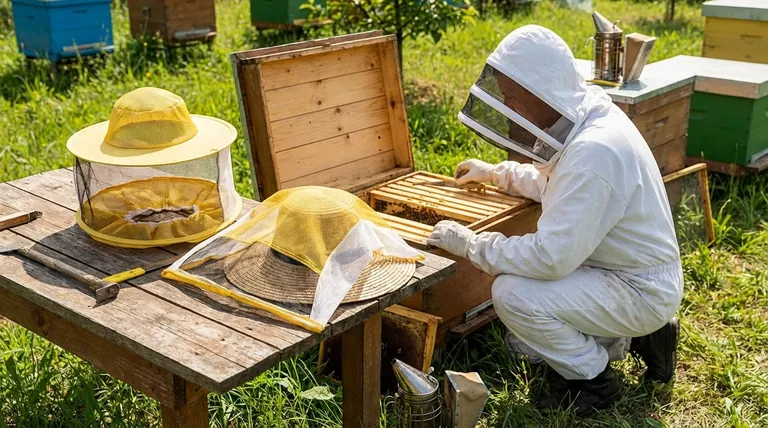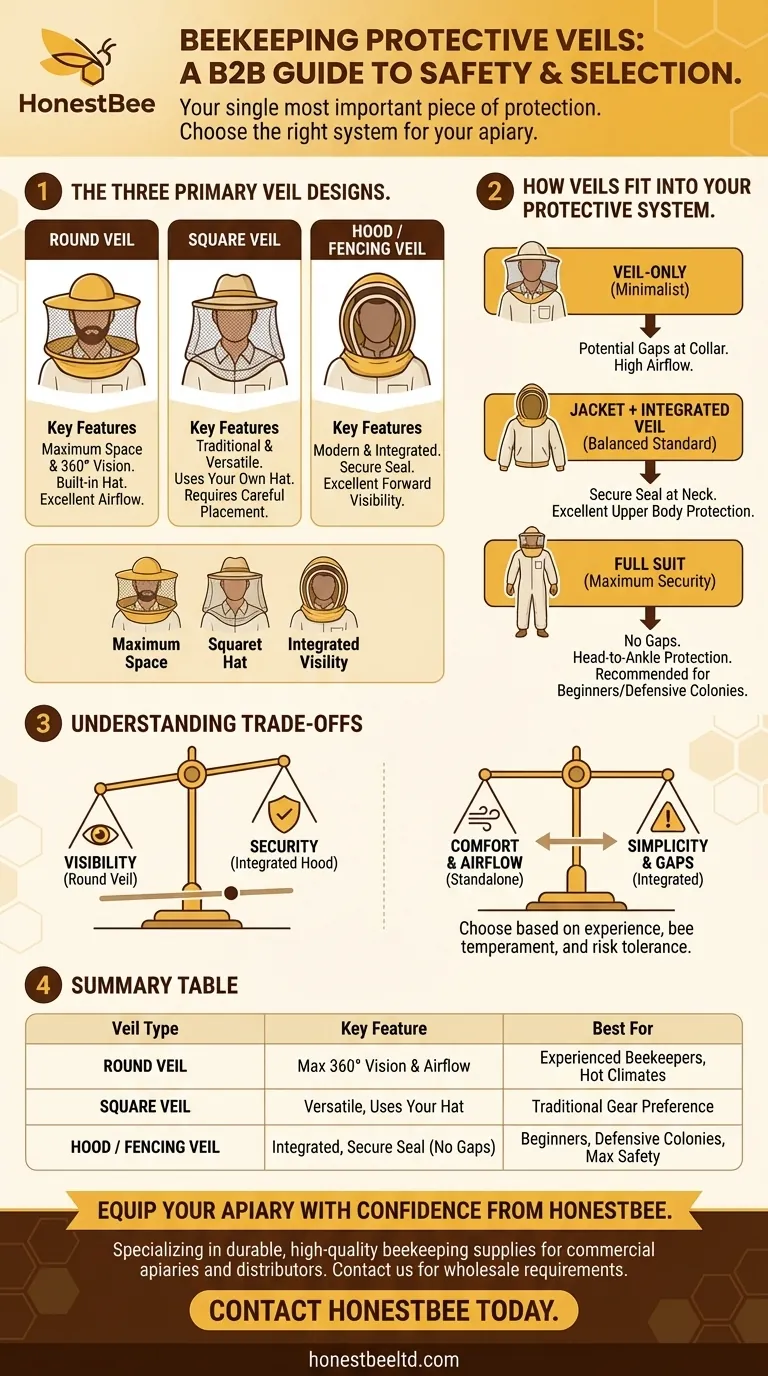In beekeeping, your veil is your single most important piece of protection. While several styles exist, they primarily fall into three categories: the Round Veil, the Square Veil, and the Hood (or Fencing) Veil. Each design offers a distinct combination of visibility, comfort, and integration with other protective gear, directly impacting your confidence and safety when handling a colony.
The question isn't just which type of veil to get, but how that veil fits into a complete protective system. The best choice depends on your personal comfort with risk and whether you prefer a standalone veil, an integrated jacket, or a full bee suit.

The Three Primary Veil Designs
Understanding the fundamental differences in veil construction is the first step. Each design was developed to solve the same problem—keeping bees away from your face—but they do so with different priorities.
The Round Veil: Maximum Space and 360-Degree Vision
The Round Veil is characterized by its built-in, wide-brimmed hat. The mesh screen forms a cylinder around your head, held taut and away from your skin by the rigid brim.
This design offers excellent, unobstructed peripheral vision and promotes significant airflow, making it a comfortable choice in hot weather. The rigid structure ensures the mesh will not be blown against your face.
The Square Veil: A Traditional and Versatile Option
The Square Veil is a simple, foldable sheet of mesh designed to be worn over your own separate, wide-brimmed hat or helmet. It drapes over the hat and is secured around your neck and shoulders.
Its main advantage is versatility; you can use your preferred hat. However, it requires careful placement to ensure there are no gaps, and the draped mesh can occasionally come into contact with your face if you lean forward.
The Hood Veil (or Fencing Veil): Modern and Integrated
This is the most common style found on modern bee jackets and full suits. Rather than relying on a hat brim, the Hood Veil uses flexible internal hoops to keep the mesh away from your face, particularly in the front.
It's often called a "Fencing Veil" because its shape resembles a fencing mask. This design offers excellent forward visibility and is easily collapsible, making jackets and suits simple to store. It zips directly onto the collar, creating a perfect seal.
How Veils Fit into Your Protective System
A veil is rarely used in total isolation. Its effectiveness is directly tied to how it connects with the clothing protecting the rest of your body.
Veil-Only: The Minimalist Approach
At a minimum, every beekeeper must wear a veil. A standalone Round or Square Veil can be used with your own thick clothing, such as canvas pants and a long-sleeve denim shirt.
This approach offers the most ventilation and freedom of movement. However, its primary weakness is the potential for a gap to form between the bottom of the veil and your shirt collar, which requires constant vigilance.
Jacket with Integrated Veil: The Balanced Standard
The most popular choice for beekeepers is a specialized jacket with an integrated veil, typically a Hood/Fencing style. The veil zips directly to the jacket's collar.
This system completely eliminates the risk of bees getting inside at your neck, offering a major security upgrade over a standalone veil. It provides excellent protection for your entire upper body while allowing you to wear your own durable pants.
Full Suit: Maximum Security
A full, one-piece bee suit offers the highest level of protection available. The veil is integrated into the suit, which covers you from your neck to your ankles.
There are no gaps between a jacket and pants for bees to exploit. This is the recommended choice for beginners, anyone with a bee sting allergy, or beekeepers working with a particularly defensive colony.
Understanding the Trade-offs
Choosing a veil involves balancing competing factors. What you gain in one area, you may sacrifice in another.
Visibility vs. Security
A Round Veil provides the best all-around, 360-degree view. However, a Hood Veil integrated into a jacket provides a more secure, bee-proof seal at the neck, even if it slightly limits peripheral vision.
Comfort and Airflow
Standalone Round and Square veils, worn with your own hat and clothing, generally offer the best ventilation. Integrated veils on jackets and suits can be warmer, as the entire garment is designed to be bee-proof and is often made of thicker material.
Simplicity vs. Gaps
The primary risk with any non-integrated, standalone veil is user error. If not secured properly, a bee can find a gap at the collar. An integrated veil on a jacket or suit removes this variable entirely, providing reliable peace of mind.
Choosing the Right Veil for Your Beekeeping Journey
Your choice should align directly with your experience, the temperament of your bees, and your personal tolerance for risk.
- If you are a beginner or prioritize maximum safety: Choose a full suit or a jacket with an integrated Hood (Fencing) Veil to eliminate any potential gaps.
- If you value ventilation and are comfortable securing your own clothing: A standalone Round Veil offers excellent visibility and airflow for working in hot climates.
- If you prefer using your own wide-brimmed hat for sun protection: A Square Veil is a versatile and traditional choice that drapes over your existing headwear.
Ultimately, the best veil is the one that allows you to feel calm, confident, and safe while working with your hives.
Summary Table:
| Veil Type | Key Feature | Best For |
|---|---|---|
| Round Veil | Maximum 360° vision & airflow | Experienced beekeepers in hot climates |
| Square Veil | Versatile, uses your own hat | Beekeepers who prefer traditional gear |
| Hood/Fencing Veil | Integrated, secure seal (no gaps) | Beginners, defensive colonies, maximum safety |
Equip Your Apiary with Confidence from HONESTBEE
Choosing the right protective gear is critical for the safety and efficiency of your beekeeping operations. At HONESTBEE, we specialize in supplying durable, high-quality beekeeping supplies and equipment directly to commercial apiaries and beekeeping equipment distributors through our wholesale-focused operations.
We understand that your business depends on reliable gear that protects your team and maximizes productivity. Let us help you outfit your operation with the best veils, suits, and equipment tailored to your specific needs.
Contact HONESTBEE today to discuss your wholesale requirements and discover how our products can enhance your safety and bottom line.
Visual Guide

Related Products
- Square Folding Bee Hat Veil with String for Beekeeping
- Heavy Duty Cowboy Beekeeper Hat with Visibility Veil Outdoor Professional Beekeeping Protective Gear
- Beekeeper Cowboy Hat and Veil for Beekeeping
- Mesh Ventilated 3 Layer Goatskin Beekeepers Gloves for Beekeeping
- JZBZ Langstroth Queen Rearing Frame for Beekeeping
People Also Ask
- Why is protecting the head important in beekeeping? Essential Safety for Every Beekeeper
- Why are a hat and veil considered the most important parts of beekeeping protective gear? Essential Protection for Your Face and Confidence
- How should the beekeeping hat veil be cleaned? The Only Safe Method to Preserve Protection
- How can beekeeping supplies and accessories enhance the hobby? Essential Tools for Safe & Rewarding Beekeeping
- What is the purpose of a hat and veil in beekeeping? Essential Protection for Head & Face



















